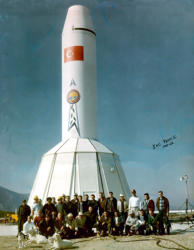
HISTORY - Page 62
By April 1958, the first tactical type launcher had been completed and successfully tested with the
lightweight erection equipment (primarily a long boom and cables). Shortly after that came R&D prototype
items such as the launcher auxiliary rings, hydro-pneumatic trailer, azimuth laying equipment, intra-
squadron communication equipment, supervisory control system, missile transporter, launcher
transporter, LOX transfer trailer, propulsion components tester, and other related items of equipment
involving both the physical handling and testing of the missile. At the Design Engineering Inspection held
on 7-10 October 1958, the GSE performed well and demonstrated that the JUPITER system could meet the
15-minute countdown-to-liftoff sequence
82
.
Progress in the GSE field was far from systematic, though. Basically, the problem was delivery of the
tactical item by the manufacturer after the prototype had been submitted by ABMA for fabrication. Also,
the Air Force had submitted more than 70 alteration requests, which, in part, may have caused some of the
manufacturing difficulties. Then, in November 1958, the mobility factor was deleted from the JUPITER
program. This meant there would be a triple launch control trailer (LCT), as opposed to the single LCT that
was necessary in a mobile weapon system. Additionally, this action eliminated the cable and launcher
transporters
83
. Together, all of these actions could have delayed the deployment of the system until
reorientation plans could have been completed, but the lack of agreement with the host country, in the
long run, provided ample time.
_____________________________







82. JUP Prog Rpt for Apr 58, 8 May 58; JUP Prog Rpt for May 58, 8 Jun 58; JUP Prog Rpt for Oct 58, 8 Nov 58, Hist Off files.
83. JUP Prog Rpt for Nov 58, 8 Dec 58, Hist Off files.



Jupiter SM-78 Weapon System
I&C Team 2, Çigli AB, Turkey 1961-1962 Chrysler Corporation Missile Division

HISTORY - Page 62
By April 1958, the first tactical type launcher had been
completed and successfully tested with the
lightweight erection equipment (primarily a long boom
and cables). Shortly after that came R&D prototype
items such as the launcher auxiliary rings, hydro-
pneumatic trailer, azimuth laying equipment, intra-
squadron communication equipment, supervisory
control system, missile transporter, launcher
transporter, LOX transfer trailer, propulsion
components tester, and other related items of
equipment involving both the physical handling and
testing of the missile. At the Design Engineering
Inspection held on 7-10 October 1958, the GSE
performed well and demonstrated that the JUPITER
system could meet the 15-minute countdown-to-liftoff
sequence
82
.
Progress in the GSE field was far from systematic,
though. Basically, the problem was delivery of the
tactical item by the manufacturer after the prototype
had been submitted by ABMA for fabrication. Also, the
Air Force had submitted more than 70 alteration
requests, which, in part, may have caused some of the
manufacturing difficulties. Then, in November 1958,
the mobility factor was deleted from the JUPITER
program. This meant there would be a triple launch
control trailer (LCT), as opposed to the single LCT that
was necessary in a mobile weapon system.
Additionally, this action eliminated the cable and
launcher transporters
83
. Together, all of these actions
could have delayed the deployment of the system until
reorientation plans could have been completed, but
the lack of agreement with the host country, in the
long run, provided ample time.
_____________________________
82. JUP Prog Rpt for Apr 58, 8 May 58; JUP Prog Rpt for May 58, 8 Jun 58; JUP Prog Rpt for Oct
58, 8 Nov 58, Hist Off files.
83. JUP Prog Rpt for Nov 58, 8 Dec 58, Hist Off files.





















